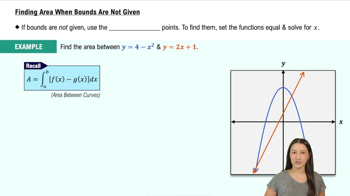Determine the area of the shaded region in the following figures.
Table of contents
- 0. Functions7h 54m
- Introduction to Functions16m
- Piecewise Functions10m
- Properties of Functions9m
- Common Functions1h 8m
- Transformations5m
- Combining Functions27m
- Exponent rules32m
- Exponential Functions28m
- Logarithmic Functions24m
- Properties of Logarithms36m
- Exponential & Logarithmic Equations35m
- Introduction to Trigonometric Functions38m
- Graphs of Trigonometric Functions44m
- Trigonometric Identities47m
- Inverse Trigonometric Functions48m
- 1. Limits and Continuity2h 2m
- 2. Intro to Derivatives1h 33m
- 3. Techniques of Differentiation3h 18m
- 4. Applications of Derivatives2h 38m
- 5. Graphical Applications of Derivatives6h 2m
- 6. Derivatives of Inverse, Exponential, & Logarithmic Functions2h 37m
- 7. Antiderivatives & Indefinite Integrals1h 26m
- 8. Definite Integrals4h 44m
- 9. Graphical Applications of Integrals2h 27m
- 10. Physics Applications of Integrals 3h 16m
- 11. Integrals of Inverse, Exponential, & Logarithmic Functions2h 34m
- 12. Techniques of Integration7h 41m
- 13. Intro to Differential Equations2h 55m
- 14. Sequences & Series5h 36m
- 15. Power Series2h 19m
- 16. Parametric Equations & Polar Coordinates7h 58m
9. Graphical Applications of Integrals
Area Between Curves
Problem 6.2.39
Textbook Question
Find the area of the region described in the following exercises.
The region bounded by y=e^x, y=e^−2x, and x=ln 4
 Verified step by step guidance
Verified step by step guidance1
Identify the curves and boundaries that enclose the region: the curves are \( y = e^{x} \), \( y = e^{-2x} \), and the vertical line \( x = \ln 4 \).
Find the points of intersection between the two curves \( y = e^{x} \) and \( y = e^{-2x} \) by setting them equal: \( e^{x} = e^{-2x} \). Solve for \( x \) to determine the left boundary of the region.
Determine which curve is on top and which is on the bottom between the intersection point and \( x = \ln 4 \) by comparing \( e^{x} \) and \( e^{-2x} \) in that interval.
Set up the integral for the area of the region as the integral from the left intersection point to \( x = \ln 4 \) of the difference between the top curve and the bottom curve: \[ \text{Area} = \int_{x=a}^{\ln 4} \left( e^{x} - e^{-2x} \right) \, dx \], where \( a \) is the intersection point found earlier.
Evaluate the integral by integrating each term separately: \( \int e^{x} \, dx \) and \( \int e^{-2x} \, dx \), then apply the limits of integration to find the area.
 Verified video answer for a similar problem:
Verified video answer for a similar problem:This video solution was recommended by our tutors as helpful for the problem above
Video duration:
4mPlay a video:
Was this helpful?
Key Concepts
Here are the essential concepts you must grasp in order to answer the question correctly.
Understanding the Region Bounded by Curves
To find the area between curves, identify the region enclosed by the given functions and boundaries. This involves determining the points of intersection and the limits of integration, ensuring the correct curves are used as upper and lower bounds within the specified interval.
Recommended video:

Finding Area When Bounds Are Not Given
Definite Integration for Area Calculation
The area between two curves y = f(x) and y = g(x) over an interval [a, b] is found by integrating the difference f(x) - g(x) with respect to x. Definite integrals compute the exact area under the curve between the limits, accounting for the vertical distance between the functions.
Recommended video:

Definition of the Definite Integral
Properties of Exponential Functions
Exponential functions like y = e^x and y = e^{-2x} have distinct growth and decay behaviors. Understanding their shapes and intersections helps in setting up the integral correctly, especially when determining which function is on top or bottom within the interval.
Recommended video:

Properties of Functions

 5:23m
5:23mWatch next
Master Finding Area Between Curves on a Given Interval with a bite sized video explanation from Patrick
Start learningRelated Videos
Related Practice
Textbook Question
10
views
